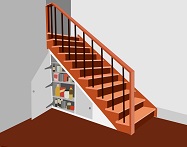 See the article on Larders in the latest Home Farmer Magazine -out today in news outlets across the UK, or subscribe online.
See the article on Larders in the latest Home Farmer Magazine -out today in news outlets across the UK, or subscribe online.
Go to https://homefarmer.co.uk/
extract from the article follows:.
In recent years as the economy has spluttered people have become more frugal. Many have shunned fast food and expensive artificial ingredients in favour of home grown produce, farmers markets, and home cooking. Along with the nation's obsession with all things culinary, having a cold food store at home has once again risen in popularity.
Larders were common in the homes of Britain before the widespread use of mechanical refrigeration in the 1960s. They then fell out of favour and all but disappeared by the late 1980s. Most people who grew up before this time will have some recollections of larders, but what were they really like?
Larders were used to keep anything from jars of pickles and jam, to tins of condensed milk and containers full of dried pulses. They were also used to store vegetables like potatoes and other root crops, cabbages and sprouts - things with a relatively long shelf life. Fruit including apples, oranges and bananas could also be kept in them. Dairy products like cheese and eggs would remain cool and cured meats such as the odd flitch of bacon may have been hung in them. Sometimes they were used to store partly prepared foods such as yoghurts whilst they fermented, or cheeses whilst they matured.
The important elements for any larder are insulation, ventilation and darkness. Make sure that the larder is sealed off with a well-fitted door and the inside is insulated with the right materials. For walk-in larders this includes the roof space.
Some suitable places for a larder include:
- A ventilated cellar
- A cool basement
- A cupboard under the stairs
- A cupboard you can insulate and vent (fitted or free-standing)
- A room off your kitchen
- An unused small room with an outside north facing wall.